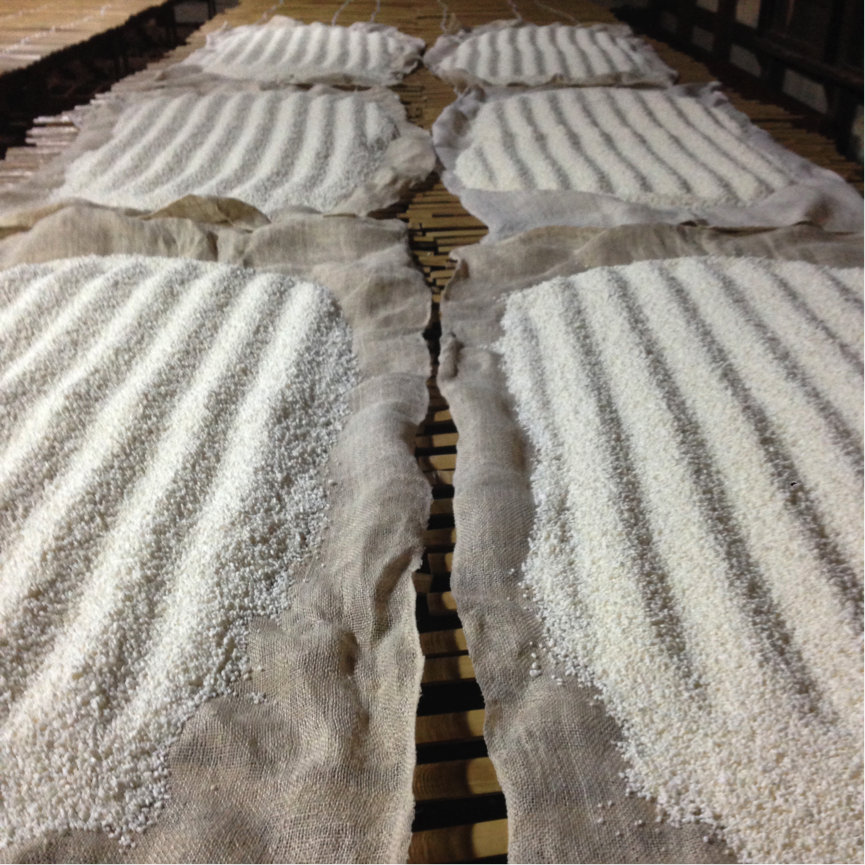 I never believed that cooked rice, unseasoned, could taste like Frosted Flakes cereal. In fact, even though the taste had changed dramatically, nothing had been added to it besides airborne spores that happened to land and propagate on each single grain of rice that I tasted.
I never believed that cooked rice, unseasoned, could taste like Frosted Flakes cereal. In fact, even though the taste had changed dramatically, nothing had been added to it besides airborne spores that happened to land and propagate on each single grain of rice that I tasted.
I truly learned about this at Chikusen Brewery in Hyogo, near Kobe. The owner, Tajime San, was showing me around; when we arrived outside of the koji room (a special room that somewhat resembles the heat and design of a sauna), he picked up a handful of this frosted, sugar-crusted looking rice, tasted it, and gestured for me to pick up a little bunch of my own koji (rice that has already been sprinkled with the koji mold spores is referred to simply as koji).
This sweet and somewhat savory taste, I learned, was the result of koji, or Aspergillus oryzae. Essentially, these spores burrow deep veins into each single grain of rice, creating a “frosted” texture on the outside, and doing this allows for the starches in the grain to be converted into the fermentable sugars appropriate for sake’s most unique process: multiple parallel fermentation.
Inside the koji room, there are specially trained kurabito (brewery workers) who sprinkle the spores in the ever-so-hot and humid koji room; they allow the mold to dry evenly, constantly evening out and moving the grains of rice around in intricate patterns so that they propagate, never clumping together.
After koji mold has been sprinkled onto the rice in the koji room and laid to dry, it’s then just called koji. This koji is ready to be thrown into a tank with yeast, water and plain steamed rice. The result is that the starches of the rice are being converted into sugar and the yeast is taking that sugar and converting it into alcohol and C02: there are two fermentations happening at the same time!
Koji is not exclusive only to sake, and although the Japanese have definitely championed it as their own unique spore, it has been seen throughout Asia in history – but it is definitely glorified by the Japanese, for good reason. Different strains of koji are also used in the production of some pillars of Japanese gastronomy, including soy sauce and miso, let alone other classic Japanese beverages such as shochu and Okinawa’s awamori. Apart from bringing these fermentable sugars to life, koji brings subtle sweetness and rich, mellow texture to the final product, all slightly tweaked depending on exactly which strain of koji is used.
After the visit to Chikusen Brewery, we went to a local izakaya (Japanese bar) where I got to drink some Chikusen with some classic bar snacks of the area. One of the bar snacks was a small piece of miso-marinated black cod. The umami and sweetness of the dish was matched with a special sake that Tajime San had brought; it was an experimental sake made with the same Koji mold that was used to produce the miso! The marriage of flavors, both in richness and texture, was sensational, and I went on to drink many, many more glasses with Tajime San that evening, feeling nothing but fresh and healthy the next morning.
Elliot Faber is the sommelier and beverage manager of two cool Japanese restaurants in Hong Kong: Yardbird and Ronin. He is also one of the world’s experts on sake, Japanese whisky, shochu, awamori and Japanese beer.

One thought on “Elliot's Article: Koji – Rice Sweetened by Spores”